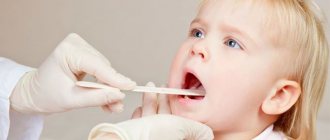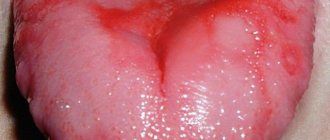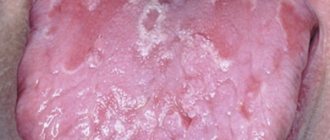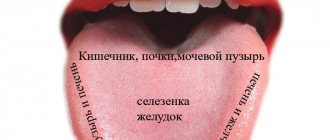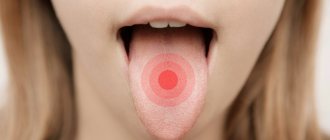What is geographic language
Geographic tongue (desquamative glossitis) is an inflammatory disease of the mucous membrane of the tongue, which is normally covered with small papillae (hairs). With the development of pathology, the latter become deformed, the surface becomes smooth and red. In appearance, the lesions resemble a geographical map with islands.
Inflammatory foci have elevated, clearly defined boundaries. They differ in their ability to heal in one place and move to another. More often there is an alternation of compactions with sagging mucous membranes.
Before prescribing treatment for a disease, it is necessary to accurately determine the causes that led to the pathology and, if possible, eliminate them, since this problem is not only cosmetic in nature, but can also lead to serious consequences.
Comments
I looked at various photos about glossitis of the tongue in your article and was horrified. Tell me, I am interested in this question: is it possible to treat this disease with folk remedies?
Reveeva Sveta (12/31/2019 at 11:43 am) Reply to comment
- Dear Svetlana, it is recommended to use traditional medicine methods only as an additional measure to the main treatment and only in consultation with a doctor. Decoctions of sage, chamomile, and oak bark effectively eliminate inflammatory processes. Soda-saline solution disinfects, tea tree oil and sea buckthorn oil heal the mucous membrane.
Editorial staff of the portal UltraSmile.ru (01/05/2020 at 09:15) Reply to comment
What happens if glossitis is not treated? The older sister seems to have it, but she doesn’t want to go to the doctor to get examined.
Marina (16.01.2020 at 18:22) Reply to comment
- Dear Marina, it is important to start treatment of the pathology in a timely manner, then the outcome is almost always positive. But if this is not done, the disease may be complicated by the formation of an abscess or phlegmon (which can spread to the neck, jaw or face). Purulent inflammations, in turn, are fraught with the development of sepsis, i.e. blood poisoning, which in extreme cases can be fatal.
Editorial staff of the portal UltraSmile.ru (01/22/2020 at 09:36) Reply to comment
Which doctors should you contact about geographic tongue? Can it appear on the sides of the tongue?
Daria (04/25/2021 at 00:12) Reply to comment
Write your comment Cancel reply
Causes
Today, the disease is quite common, but despite this, it has not been fully studied, especially the etiology. It was possible to identify a number of reasons that contribute to its development:
- Diseases of the digestive system.
- Pathologies of the thyroid gland.
- Liver diseases.
- Disorders in the circulatory system.
- Malignant and benign tumors.
- Autonomic-endocrine disorders.
- Infectious processes.
- Autoimmune diseases.
- ARVI, ARZ.
- Pathologies of the nervous system.
- Allergic diathesis.
- Pathologies occurring in the oral cavity.
- Hereditary genetics.
- Avitaminosis.
- Chronic skin diseases.
- Stressful situations.
- Diabetes.
- Long-term therapy with antibiotic drugs.
In childhood, desquamative glossitis can manifest itself against the background of general diseases of the liver, kidneys, pancreas, spleen, and desquamative glossitis. In girls, it is more often observed before the first menstruation or during bleeding.
The disease can occur either independently or as a symptom of a concomitant disease. Therefore, it is divided into primary and secondary desquamative glossitis.
Primary glossitis most often occurs when the tongue is injured by sharp edges of teeth or dentures, as well as from chemical or thermal burns. In young children, geographic tongue is diagnosed during teething.
The development of the secondary form occurs as a result of pathological reactions in the human body. This is observed due to increased sensitivity to changes in the mucous epithelium of the tongue. Such changes are promoted by chronic diseases of the liver, gall bladder, severe vitamin deficiency and others. The pathology often begins with colds, scarlet fever, measles, and typhoid fever.
Is glossitis contagious?
It comes as a surprise to many people that the disease can actually be contagious. Here you need to understand that if glossitis of the tongue occurs due to non-infectious causes, for example, mechanical injuries and burns, then it is not contagious. If the cause of its development is infections, viruses and bacteria, for example, staphylococcus, streptococcus, herpes virus or candida fungi, then the pathology can become dangerous not only for you, but also for others and family members.
In addition, glossitis on the tongue may indicate that you have problems in the body, which again can be contagious to outsiders: diphtheria, helminthic infestations, tonsillitis, scarlet fever, syphilis.
Notice
: Undefined variable: post_id in
/home/c/ch75405/public_html/wp-content/themes/UltraSmile/single-item.php
on line
45 Notice
: Undefined variable: full in
/home/c/ch75405/public_html/wp-content /themes/UltraSmile/single-item.php
on line
46
Rate this article:
( 10 ratings, average: 4.90 out of 5)
language
- E.V. Borovsky, A.L., Mashkilleyson M. Diseases of the mucous membrane of the oral cavity and lips, 1984.
Consulting specialist
Dzagurova Elina Ruslanovna
Doctor rating: 9.5 out of 10 (2) Specialization: Dentist-therapist Experience: 11 years
Symptoms
Geographical language is manifested by the following features:
- Cloudiness of the mucous membrane - during the initial development, a whitish coating with a gray tint appears. The lesion is small - no more than three millimeters.
- Detachment of the papillae - with further development, the papillae desquamate, and underneath there is an area of bright red color, which stands out strongly against the general background of the tongue. Such an “island” can grow and move, but the boundaries remain clear.
When the focus becomes as large as possible, the boundaries are not so clearly defined and begin to blur. In the center of the lesion, the mucous membrane takes on a normal state, and along the borders keratinization and peeling (desquamation) are observed. Since the affected areas are capable of displacement, desquamation is layered one on one.
That is, new lesions appear on old lesions, the mucous membrane becomes similar to a geographical map. This process is characterized by the fact that all areas of the tongue are affected, excluding the lower part. And this picture can change daily.
Desquamative glossitis manifests itself without pronounced symptoms, so many people learn about the disease only when examined by a doctor. Occasionally, patients complain of itching and burning, discomfort while eating, and impaired sensitivity to the taste of food.
All about the symptoms and treatment of glossitis
The main symptom of the disease is the appearance of the tongue. Some patients, as a result of the disease, develop a pathological fear for their life, a panicky fear of the appearance of a malignant tumor (cancerophobia).
The development of pathology is influenced by severe stress, and it does not matter what emotions a person experiences: positive or negative. In approximately half of the cases, a parallel course with the folded tongue is observed.
Despite the fact that the pathology does not bring much discomfort, the patient is frightened by the very sight of the affected organ, which is stressful and accordingly worsens the course of the disease.
A feature of desquamative glossitis is its complete disappearance, more often for a long time, but then the symptoms reappear.
Incredible!
Language helps you see. A revolutionary technology that makes it possible to partially restore vision to blind people using the nerve endings of the tongue was created by American scientists. The theoretical basis for the latest technology was laid back in the 1960s by the famous neurosurgeon Paul Bach y Rita. He suggested that a person sees not with his eyes, but with his brain. In this case, vision serves only as a “delivery” of external light signals. Now these scientific assumptions have been confirmed in practice, when scientists have created a special device that largely restores vision. It consists of glasses that capture light and transmit information to a special miniature device. The latter converts light waves into electrical signals that are sent through a thin cable to the tongue. The tongue was chosen as a channel for transmitting signals to the brain, since its nerve endings are very sensitive and capable of transmitting a large amount of information. Thus, the tongue partially replaces the 2 million optic nerves that lead from the human eyeball to the brain. As it turns out, the impulses received by the tongue are converted into images in the brain. The magazine reports that during the tests, blind people using the latest device were able to see the door, floor call buttons in the elevator, and even letters.
Diagnostics
Making a correct diagnosis is not particularly difficult, so any doctor can recognize the geographic language based on the following studies:
- Collection of anamnesis, which is based on the patient’s complaints and examination data.
- General analysis .
- Bacteriological culture to detect pathogenic microorganisms and determine the causative agent of the disease.
- Polymerase chain reaction (determination of the pathogen by DNA).
- Enzyme immunoassay (presence of non-standard antibodies).
- Scraping the mucous membrane of the tongue to identify treponema pallidum (if syphilis is suspected).
- analysis to detect worms.
To differentiate from other diseases, the doctor focuses more on the movement of lesions.
Treatment
Treatment is primarily aimed at eliminating the cause (problems with the gastrointestinal tract, bad habits, endocrine disorders in the body).
- Sanitation of the oral cavity – treatment of carious teeth, maintenance of oral hygiene.
- Diet – the patient is prescribed a special diet that does not contain foods and drinks that irritate the oral mucosa. For example, hot, spicy and smoked dishes, carbonated and alcoholic drinks and others.
- Quitting tobacco products.
- Local treatment involves the use of antiseptic rinsing solutions. The most commonly prescribed drugs are Chlorhexidine, Miramistin, Furacilin, and potassium permanganate.
- Novocaine blockades - injections into the area of the lingual nerve (10 injections per course).
- Solutions with an analgesic effect - in the presence of ulcers and erosions. Treated with an antiseptic solution using a tampon.
- Preparations to boost immunity: vitamin complexes, immunostimulants, antihistamines.
- Ointments – have a healing and analgesic effect, applied in the form of applications. The specialist often prescribes Actovegin, Kamistad, Lidocaine.
- Antibiotics - when purulent processes are detected in the oral cavity, regional lymph nodes and tissues: Tetracycline, Doxycycline, Rocephin, Suprax and others. In the most advanced situations, surgical intervention is prescribed.
- Mycotic drugs when fungal microorganisms are detected: Lamisil, Nystatin, Exifin.
Some patients with cancerophobia need psychological help; this requires consultation with a psychologist or psychotherapist.
Complications
The development of desquamative glossitis should not be ignored, and if detected, you should seek the help of a specialist. Many patients, having discovered a similar pathology in themselves, mistakenly take it for a cancerous tumor, although in fact the geographical language has nothing in common with it.
This benign disease does not have a tendency to become malignant; it is treated by a dentist and a gastroenterologist; in serious cases, an examination by a hematologist, gastroenterologist and endocrinologist is required.
If therapeutic measures to eliminate the geographic tongue are not carried out in a timely manner, the disease takes on a more advanced form with relapses and will be more difficult to treat. In addition, there is a risk of swelling of the tongue, which adversely affects breathing; chewing and swallowing functions are also affected. Next, the process involves regional tissues and organs.
Deep type
Glossitis, as in the photo, affects the entire surface and thickness of the tongue. The photo shows that the disease has affected the root and frenulum.
In the deep form, the tongue is completely affected
It is characterized by the formation of ulcers, deterioration of the patient’s condition, and throbbing, sharp pain. The tongue swells, which makes speech difficult, and the process of chewing and swallowing food, as well as breathing, is disrupted. If treatment is not started, a person will develop an abscess or phlegmon, spreading to the surrounding tissues up to the cervical areas.
Prevention
To prevent the development of such a disease, you need to follow some simple preventive rules:
- Promptly treat all diseases that provoke the development of pathology.
- Do not abuse alcoholic beverages, tobacco products, sweet foods and sugar, and strong coffee.
- Take enough vitamins to avoid vitamin deficiency.
- Perform hygiene .
- Treat caries in a timely manner.
There are separate preventive measures for children:
Caring for baby teeth – timely treatment and removal of baby teeth. If a child complains of dry mouth, rinse with herbs such as sage, St. John's wort or chamomile.
Brushing your teeth should be done only with toothpastes, since the powders contain mint oil and menthol, which are bad for the oral mucosa in children.
Purely concrete
The mandatory daily ritual of brushing your teeth should also include a tongue cleansing procedure. The heterogeneous microrelief of this organ, consisting of papillae of different sizes, is an ideal field for the proliferation of pathogenic bacteria.
The most plaque accumulates in the morning. Therefore, it is better to carry out this procedure at this time of day. Today there are special tongue brushes made of metal, rubber or plastic on sale. But you can get by with improvised means. A regular teaspoon will do. After dipping it in warm water, you need to gently scrape it across your tongue until there are no traces of plaque left on the spoon. After cleaning, the tongue should be lubricated with olive or any other vegetable oil to prevent irritation. A cleaned tongue looks refreshed and healthier. In addition, after this procedure, the taste of food is revealed in a new way, and all the nuances of the taste of well-known dishes are felt much brighter. The use of a brush is especially necessary:
● in the presence of a large amount of plaque; ● with deep cracks in the tongue; ● when there is bad breath; ● smokers.
Another way to cleanse the tongue is the famous lion pose. With your eyes widened and your mouth wide open, you need to stick your tongue out as far as possible, trying to reach your chin. During the exercise, you need to strongly strain the muscles of the face, neck and chin for 5 seconds. Then you can relax for 15 seconds and then repeat the same pose again. 5-6 repetitions are enough. This exercise relieves inflammation of the tonsils, improves thyroid function and eliminates bad breath.
